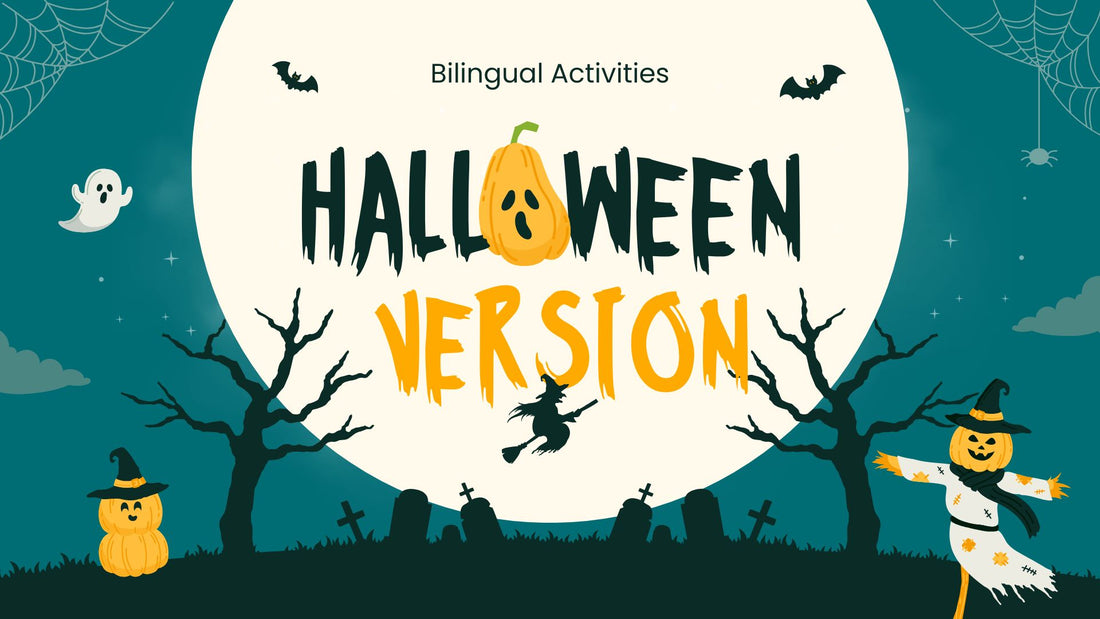Halloween is a time for spooky fun, creative costumes, and plenty of candy—but it's also an opportunity to create family traditions that celebrate culture, creativity, and language. For bilingual families, Halloween can offer a unique chance to incorporate both languages into the festivities, making the holiday even more enriching and memorable for children.
Whether you're navigating Halloween in two languages for the first time or looking to add a bit more cultural flair to your celebration, there are endless ways to weave bilingual elements into the traditions and activities. Here are some ideas to inspire your Halloween celebrations that embrace both the fun of the holiday and the beauty of being bilingual.
1. Creating Bilingual Costumes
One of the most exciting parts of Halloween is dressing up, and this can be a fantastic opportunity to introduce new words and concepts in both languages. For example, you could have your child dress up as their favorite animal or character, but with a bilingual twist—encourage them to use both language versions of the costume. If they're dressing up as a "pirate," you could teach them how to say "pirate" in both languages. You could even make a game of it, where your child has to use the new word when talking about their costume to get a treat.
2. Bilingual Halloween Story Time
Reading Halloween-themed books is a great way to incorporate language practice while also fostering a love for spooky stories. Many Halloween books are available in both English and other languages. You can choose one book and read it first in one language and then in the other, helping your children learn new vocabulary while keeping them engaged with a fun story.
Or, simply tell your own Halloween stories in both languages. For instance, you could narrate a tale of a friendly ghost or a pumpkin patch adventure, switching between languages as the story progresses. This keeps your kids engaged while also allowing them to hear new words in context.
3. Halloween Word Scavenger Hunt
Set up a bilingual Halloween-themed scavenger hunt! Prepare a list of Halloween-related vocabulary in both languages and hide items around the house or yard that correspond to those words. For example, you could hide:
- A small pumpkin
- A plastic spider
- A witch’s hat
As your child finds each item, encourage them to say the word in both languages. This fun activity not only makes for a great game but also reinforces language learning in a natural, playful setting. You can even give out little treats or prizes to reward their efforts!
BONUS: Free Printables - Halloween Scavenger Hunt in multiple languages

Download here for English, Italian, Japanese, Simplified Chinese, Traditional Chinese, Hindi
4. Bilingual Trick-or-Treating
If you live in a bilingual community, trick-or-treating can be a perfect opportunity for children to practice their language skills while enjoying the holiday. Encourage your children to greet neighbors in both languages with a friendly Trick or Treat! depending on your languages.
Make it even more interactive by teaching them Halloween phrases in both languages, like:
- Do you have candy?
- Thank you
This not only reinforces the vocabulary but also fosters an appreciation for the cultures that you celebrate as a family.
5. Crafts and Decorations
Crafting is a perfect Halloween activity that can be made bilingual. Set up a craft station where your kids can create their own spooky decorations like ghosts, bats, or pumpkins. While you work together, talk about the materials and actions in both languages.
For instance, you could introduce vocabulary related to crafting:
- paper
- scissors
- glue
- pumpkin
- bat
- black colour
- orange colour
As you create, encourage your children to say the names of objects or actions out loud in both languages. It makes the activity more engaging and helps them retain new words.
6. Cultural Connection: Halloween and Día de los Muertos
In many bilingual households, especially those with Latin roots, Halloween is often closely followed by Día de los Muertos (Day of the Dead), a vibrant celebration of loved ones who have passed away. These two holidays can be a beautiful opportunity to merge cultures.
You could teach your children the differences and similarities between Halloween and Día de los Muertos. For example:
- Halloween is more of a spooky, playful holiday, while Día de los Muertos is a time of remembrance and honoring ancestors.
- In both holidays, decorations such as pumpkins, skeletons, and spooky figures are common, but in Día de los Muertos, the use of colorful skulls (calaveras) and marigolds (cempasúchil) is significant.
Together, you could make a bilingual Halloween-to-Día de los Muertos transition activity, such as creating sugar skulls, decorating with marigolds, or even preparing an altar (ofrenda) with bilingual labels for each item. This can be an educational and emotional bridge for children, linking traditions and language in a meaningful way.
7. Halloween-Themed Songs
Songs are an excellent way to reinforce language learning. Sing Halloween-themed songs in both languages, or create a bilingual version of your favorite Halloween tunes like "Five little pumpkins"
This not only makes for an entertaining activity but also gives your children a chance to hear new vocabulary in context.
I hope this blog inspired you to celebrate Halloween with your kids while reinforcing bilingualism at home!
Let me know if you find the printables helpful! :)

